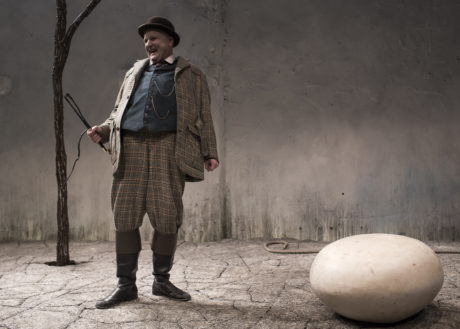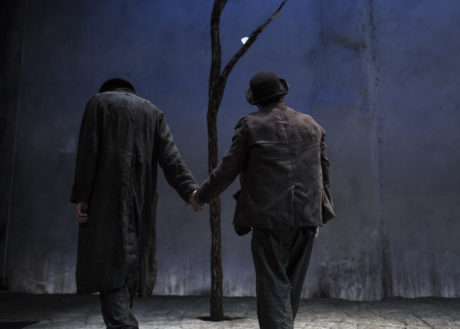Bleak? Nope, not at all. Galway, Ireland-based theater company Druid’s touring production of Samuel Beckett’s warhorse of postwar failure and ennui, Waiting for Godot, at Shakespeare Theatre Company is glorious.

Why? Because I fell in love with 50 kilos of rusted 6-inch boat nails.
Then again, I have dendrophilia.
For those who know Beckett’s stage direction about his country road with a leafless tree (Act I), Druid’s nude tree is not forlorn or to be mistaken for a bush or a shrub. It is not weak in appearance even with its slight curve from where winds have blown against it for decades. It is certainly not a location for a hanging. Nope, the tree is very much alive; a solid object of veneration, even succor. (Then again, I often think of Stanley Kubrick’s black monolith from 2001: A Space Odyssey when I take in Beckett’s famous stage tree. They have similar purposes of evoking awe and the unknown).
Yeah, clearly I have a fetish problem. But I admit it.
Recently, I was fortunate to have a behind-the-scenes tour and conversation with Waiting for Godot Production Manager, Barry O’Brien, to learn more about how Druid made its way from Ireland to Washington with tree intact. Since I am a geek when it comes to creative teamwork, I figured there must be some mysteries regarding where the tree came from and how it was created.
My conversation with O’Brien was followed with a roundtable chat with Shakespeare Theater Company’s Master Electrician, Sean McCarthy; Audio/Video Supervisor, Brian Burchett; Stage Operations Supervisor, Will Gautney; and Associate Director of Production, Kimberly Lewis Barna. With the STC staff, I wanted to learn more about working with a touring company as opposed to developing a production totally in-house.
So, first a spoiler alert. This column is not about the first-rate Druid production itself. It is more about what goes into bringing a touring production to the Lansburgh stage–which is considerably different than mounting a show from start to finish with in-house talent.

From Druid Production Manager Barry O’Brien, I learned backstage details. The 50 kilos of nails came from Maine, from an old-line firm in an area where galvanized nails are still needed for wooden ships and boats. The 50 kilos of nails cover a metal substructure. Each nail is separately and meticulously spot welded. But, wait, I know from too many summer jobs (and my Dad who was good with tools and teaching) that galvanized nails are specially coated so they don’t rust.
How did the rusted nails come to be? O’Brien’s tale made sense to me. The nails were soaked in an acidic solution over some days to remove the coating. Then they were placed in water, then exposed to the air. Voila, a rust skin appeared. Once rusted, the nails became part of an approximately 17-foot-tall tree that fits the Lansburgh stage well.
But the tree is also built strong, since it must withstand many load-ins into a venue, then be broken down during strike for hauling to a theater venue somewhere in Ireland, and then across the pond to DC. That is no weak tree at all. I told you I had a fetish.
From O’Brien, I learned that even Godot’s rising moon has its own story. In this case, the moon has a slight rise, as it comes into view. That little rise had to be specially constructed and motorized. The famous Godot stage rock was likewise fabricated. But there has been a time or two in Ireland when a real, local rock was used.
From the STC production staff, I learned much about successfully bringing a touring company to DC audiences. This involves not just creative talents, but, but business skills par excellence. With each touring company, there are detailed written riders between the touring company and STC that lay out contractual responsibilities. Who does what, what is needed, who has what, even how many people are needed to get the show loaded in and ready for opening night. Even the rise and size of the stage can be delineated. (Some of the stages in Ireland are smaller than the Lansburgh, as an example). And as in any business venture, even with a written rider; trust and compromise are key.
Let me end with this. Those 50 kilos of nails that became the outer rusted skin for the trunk and branches of Beckett’s Waiting for Godot tree, for me, are every bit as worthy of a front-page headline, as say, a First Lady’s recent choice of a wide-brimmed hat splashed across newspapers. Think of it this way, just as the First Lady’s hat did, the tree set “the tone and stole the show.”

When I saw the actual Druid production of Waiting for Godot, I cast my eyes on the tree at stage right–at a distance and with theater lighting including some exquisite purple nighttime effects. I sighed in happiness. As the real world outside continues to fall into chaos with no end point in sight, Beckett’s tree had me feel that there is something solid in this world; something to depend on. What was once a symbol of anarchy had become a symbol of solid resistance. I can count on the tree. I love the new, but damn, it’s good to have Godot and that tree with us still.
Running Time: Approximately two hours and 45 minutes, with one intermission.
Waiting for Godot, presented by Druid, plays through May 20, 2018, at Shakespeare Theatre Company’s Lansburgh Theatre – 450 7th St NW, Washington, DC. For tickets, call the box office at (202) 547-1122, or purchase them online.
LINK:
Review: ‘Waiting for Godot’ by Sophia Howes




